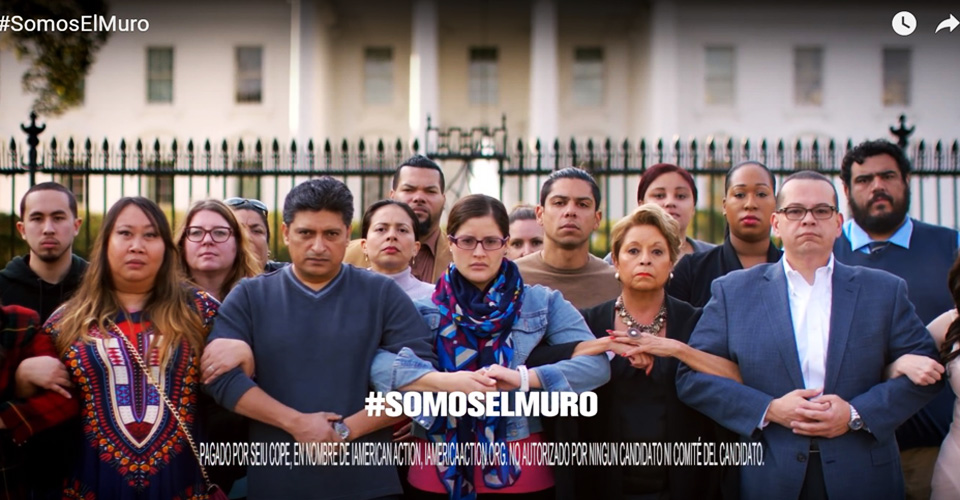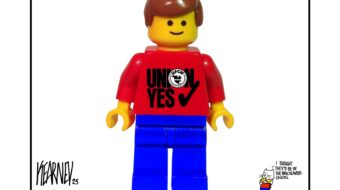
With the November 8 election just around the corner, the nation’s unions are ramping up their final political push to contact members and their families, canvass hard in key swing states and elect worker-friendly officials up and down the ballot.
And it’s not just for Hillary Rodham Clinton, either.
With Clinton, the Democratic presidential nominee, apparently widening her lead over GOP business mogul Donald Trump, workers and their allies are hitting the hustings to lock in her victory, but also campaigning in down-ballot races, too – from senators and governors to local ordinances and city councils.
“Pay attention to the presidential, Senate and congressional races,” Graphic Communications Conference/Teamsters President George Tedeschi advised in the latest Graphic Communicator. “Compare the candidates. Don’t get distracted by side issues – the kind politicians use to divide the country and unsettle the electorate.
“Be a solid citizen, proud American and responsible union member. Vote. No excuses,” he declares.
The effort to ensure that outcome starts at the top, with the AFL-CIO and Change To Win, along with individual unions.
The AFL-CIO, leading the national drive, set a goal of having 100,000 volunteers knock on a million doors between mid-October and Election Day, federation President Richard Trumka said. It planned to send 424,000 pieces of direct mail – with at least 67,000 in Florida alone – and 1.4 million cards telling voters which candidates stand with workers. Other top states are Missouri, Nevada, North Carolina, Ohio, Pennsylvania and Wisconsin (See Missouri stories in this edition.).
“This is the peak of our political program. Together we will elect Hillary Clinton as the first woman president, and work with her administration to rewrite the economic rules so that working people can get ahead and stay ahead,” Trumka explained.
But the AFL-CIO mailers also hit Trump: In Florida, for example, they note he refused to hire U.S. workers at his Mar-A-Lago resort.
CTW unions both joined the AFL-CIO-led crusade and campaigned on their own. The Service Employees, one of two big CTW unions, particularly targeted Spanish-speaking voters, both in ads and on the ground.
SEIU’s latest ad flips Trump’s declaration that he’ll “build a wall” between the U.S. and Mexico, to keep Latinos and Latinas away, and to deport those already here, on its head.
“#SomosElMuro, we are the wall that will keep you away from the White House,” the ad says. Visually it shows dozens of Latinos linking arms in front of the White House, sending a message that “We have the power to defeat you.”
The ads, costing an estimated $3 million, ran in Miami, West Palm Beach, Tampa, Orlando and Fort Myers, Fla., Las Vegas and Reno, Nev., and on all four national Spanish-language networks, along with cable.
“Tenemos 27 miliones de votos. Y juntos somos el muro entre tu y la presidencia,” the ad concludes. “We have 27 million votes. And together, we are the wall between you and the presidency.” Adds SEIU Executive Vice President Rocio Saenz: “No, Donald Trump, you won’t build your wall, because we are the wall between your hate, your disrespect, your insults and the presidency.”
SEIU’s ads complement an AFL-CIO campaign aimed at Hispanic-Americans in the Sunshine State, and particularly in its heavily Hispanic “I-5 corridor” around Orlando.
“We call upon Latino workers across this country to say ‘no mas,’” Food and Commercial Workers Secretary-Treasurer Esther Lopez said, according to American Income Life’s Labor Letter. Unions planned to turn out 1,000 volunteers and staff to campaign in Florida against “the politics of hate,” AFL-CIO Executive Vice President Tefere Gebre added.
But labor campaigners are also urging voters to look beyond Clinton and Trump.
“Politics matter, our votes matter,” Philadelphia security officer Karen Bond told SEIU. Her state is both a swing state in the presidential contest and has a close U.S. Senate race which could help tip the upper chamber of Congress back to pro-worker officeholders.
Trump and incumbent GOP Sen. Pat “Toomey don’t care about working people. Trump says wages are ‘too high’ and they both oppose raising the minimum wage. They can’t relate to what I go through every day. Hillary Clinton, and candidates for Senate and other offices like Katie McGinty” – Toomey’s Democratic foe – “are in my corner, fighting for me. That’s why I am showing up to fight for them!” Bond said.
In Nevada, yet another swing state, Unite Here Culinary Workers Local 226 – with 55,000 members, one of the largest locals in the U.S. – mobilized not just for Clinton but for U.S. Senate and congressional candidates. It also spent the early part of this year registering thousands of new Latina and Latino voters, spokeswoman Beverly Khan said.
That local is particularly concentrating on electing former Nevada Attorney General Catherine Cortez-Musto to be the first Latina U.S. senator and it‘s campaigning for State Sen. Ruben Kihuen for the U.S. House against incumbent Republican Cresent Hardy.
Local Secretary-Treasurer Geoconda Arguello-Kline calls Cortez-Musto, running to succeed retiring Senate Democratic Leader Harry Reid, “a hard-working Nevadan who will deliver results in Washington and fight for our loved ones.” And she adds “the time has come to break yet another barrier for Latinos in the country.”
Besides the ads and the ground game, other unions joined the Labor Action Network, which sorts out potential voters and tailors messages to them, the Road Sprinkler Fitters Local 669 and the United Association of Plumbers and Pipefitters report.
“The LAN is a secure voter file system that tracks the voting habits and histories of AFL-CIO union members,” they explained. “It allows us to do specific targeting to reach the members who we need to reach while excluding those we do not. In other words, it helps us work smart and efficiently.
“By using the LAN, we can create contact lists to be used for phone banks, door-to-door canvassing, and mailings. Most importantly, we can target specific groups of voters… We can also contact voters most and least likely vote. By being able to separate different voters into different groups, instead of calling every member, we can target only members who need to be contacted. We can tailor messages that will be most effective for that specific group.”










